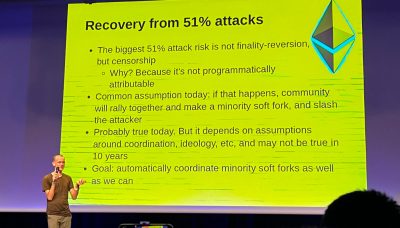Vitalik Buterin advocates for automated responses to 51% attacks
Buterin envisions reduced reliance on social consensus with new Ethereum defense mechanisms.

Key Takeaways
- Buterin proposes automated software for Ethereum validators to counteract 51% attacks.
- The new system aims to minimize the need for social consensus in attack responses.
Share this article
Ethereum co-founder Vitalik Buterin has called for the network to develop more automated defenses against potential censorship resulting from 51% attacks.
It's time! It's time! @VitalikButerin is speaking right now in the Gold Hall 🥳
We have a full house of eager beavers ready to hear his keynote 🦫✨
If you can't find a seat, please check out the streams in the Silver and Copper Halls 🫶 pic.twitter.com/e9xpRFy29s
— EthCC – Ethereum Community Conference (@EthCC) July 10, 2024
The Ethereum co-founder arrived at the Ethereum Community Conference (EthCC) in Brussels as a storm began. During his keynote speech, Buterin emphasized the need for Ethereum to be better prepared to pivot if malicious actors gain control of the network. He advocated for increased research and development of automated responses to 51% attacks, where a bad actor produces more blocks than honest validators.
Buterin highlighted censorship as a major concern in such scenarios. While the current plan relies heavily on social consensus to coordinate a chain fork, he argued for a more automated approach.
“We want to make the response to 51% attacks be something that is as automated as possible,” Buterin stated.
Buterin suggests that validator nodes should run software capable of detecting censorship and automatically counter-censoring the majority chain.
The Ethereum co-founder acknowledged the challenges in achieving 100% network participation in an automated fork, but also stressed that increased automation would reduce the burden on social consensus. He claims that there is a need for the technological layer to present a clear, viable soft fork option for the community to rally around if needed.
Beyond 51% attack responses, Buterin outlined other suggestions for Ethereum’s development. He advocated for wider adoption of light clients in the network’s infrastructure, including wallets, and support for zk-EVM verification to bolster Layer 2 networks. Buterin also addressed quantum resistance concerns, noting that while Ethereum faces risks in four areas (Merkle trees, consensus signatures, blobs, and user accounts) solutions already exist for each.
These proposals align with Buterin’s broader vision for Ethereum’s evolution, emphasizing protocol simplification to enhance usability for developers and users. By focusing on automated defenses and infrastructure improvements, Ethereum aims to strengthen its resilience against potential attacks while improving its overall functionality.
